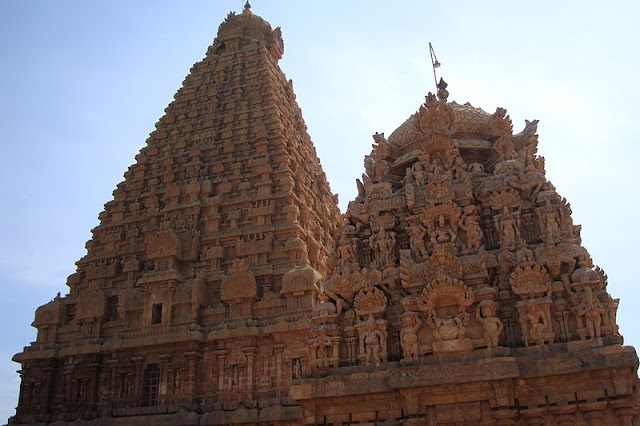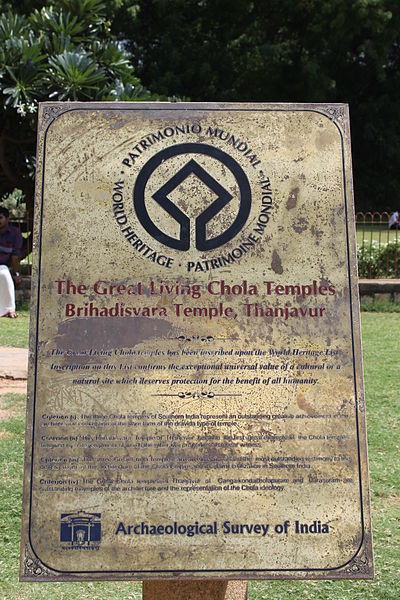Brihadeeswarar Temple, Tanjore
Brihadeeshwara Temple (Peruvudaiyar Kovil) is a Hindu temple dedicated
to Shiva located
in Thanjavur in
the Indian state of Tamil Nadu.
It is also known as Periya Kovil, RajaRajeswara Temple and Rajarajesvaram. It
is one of the largest temples in India and is an example of Dravidian architecture during the Chola period.
Built by emperor Raja Raja
Chola I and completed in 1010 AD, the temple turned 1000 years old
in 2010. The temple is part of the UNESCO World Heritage Site known as the "Great Living Chola Temples", with the
other two being the Brihadeeswarar Temple, Gangaikonda
Cholapuram and Airavatesvara temple.
The temple stands amidst fortified walls that were
probably added in the 16th century. The vimanam (temple
tower) is 216 ft (66 m) high and is the tallest in the world. The Kumbam (the
apex or the bulbous structure on the top) of the temple is carved out of a
single rock and weighs around 80 tons. There is a big statue of Nandi (sacred
bull), carved out of a single rock measuring about 16 ft (4.9 m) long
and 13 ft (4.0 m) high at the entrance.
The entire temple structure is made out of granite,
the nearest sources of which are about 60 km to the west of temple. The
temple is one of the most visited tourist attractions in Tamil Nadu.
Temple Timeline
For brief details, please
refer;
Myths & Features
For brief details, please
refer;
History
For brief details, please
refer;
Rajaraja Chola the Great – Builder
For brief details, please
refer;
Temple Construction
For brief details, please
refer;
Temple complex
The temple complex sits on the banks of a river that was
channeled to make a moat around the complex's outer walls; the walls were being
built like a fortress. The complex is made up of many structures that are
aligned axially. The complex can be entered either on
one axis through a five-story gopuram or
with a second access directly to the huge main quadrangle through a smaller
free-standing gopuram.
The massive size of the main Vimanam (Shikhara)
is ca. 60.96 meters high, with 16 elaborately articulated stories, and dominates
the main quadrangle. Pilaster, piers (a raised structure), and attached columns are
placed rhythmically covering every surface of the Vimanam. The gopuram of
the main entrance is 30 m high, smaller than the vimana.
It is unusual in the Dravidian architecture where the gopurams
are generally the main towers and taller than the vimanam.
Gopurams
For brief details, please
refer;
Maratta Mandapam & Paintings
For brief details, please
refer;
Murals/Frescos
For brief details, please
refer;
Main Nandhi
For brief details, please
refer;
Nandhi at the top of Sri Vimana
For brief details, please
refer;
Nandhis & Lingas on Praharam & Walls
For brief details, please
refer;
Sculptures
For brief details, please
refer;
Deities
For brief details, please
refer;
Main Shrine & Sri Vimana
For brief details, please
refer;
Subsidiary Shrines
Periyanayaki
Amman Shrine:
For brief details, please
refer;
Chandeshwara
Shrine:
For brief details, please
refer;
Shubramanya
Shrine:
For brief details, please
refer;
Ganesha
Shrine:
For brief details, please
refer;
Karuvurar
Shrine:
For brief details, please
refer;
Varahi
Amman Shrine:
For brief details, please
refer;
Dakshinamoorthy
Shrine:
For brief details, please
refer;
Inscriptions
For brief details, please
refer;
Adjoining structures
Surrounding the main temple are two walled enclosures.
The outer wall is high, defining the temple complex area. Here is the massive
gopuram or gateway mentioned above. Within this a portico,
a barrel
vaulted gopuram with over 400 pillars,
is enclosed by a high wall interspersed with huge gopurams axially lined up to
the main temple. It was built by Rajaraja Brahmarayan (Krishnan Raman).
Krishnan Raman was
an officer in the Chola army who served as the Commander-in-chief of the Chola
forces under Rajendra Chola. He held the title Mummadi Brahmarayar
Niyomanam. Krishnan Raman is known for the religious
endowments he made.
He was one of the main donors to the Brihadeeswarar temple at Thanjavur. Inscriptions in the Rajarajesvaram temple
indicate that Krishnan Raman constructed the fortifications around the temple.
This wall is known as Krishnan Raman Tiruchurrumaligai. This is one of the oldest surviving defensive
walls around any Chola temple. A metal image of Ardhanariswara was donated by
him in 1014 AD.
Attractions
For brief details, please
refer;
Devadasi Traditions
For brief details, please
refer;
Temple personnel
For brief details, please
refer;
Pooja Timings
For brief details, please
refer;
Festivals
For brief details, please
refer;
Car festival
For brief details, please
refer;
Security at the Temple
For brief details, please
refer;
Beliefs
For brief details, please
refer;
Millennium commemoration
For brief details, please
refer;
Popular culture
For brief details, please
refer;
Best Time to Visit
For brief details, please
refer;
Visitor Information
For brief details, please
refer;
Connectivity
For brief details, please
refer;
Photos




































































